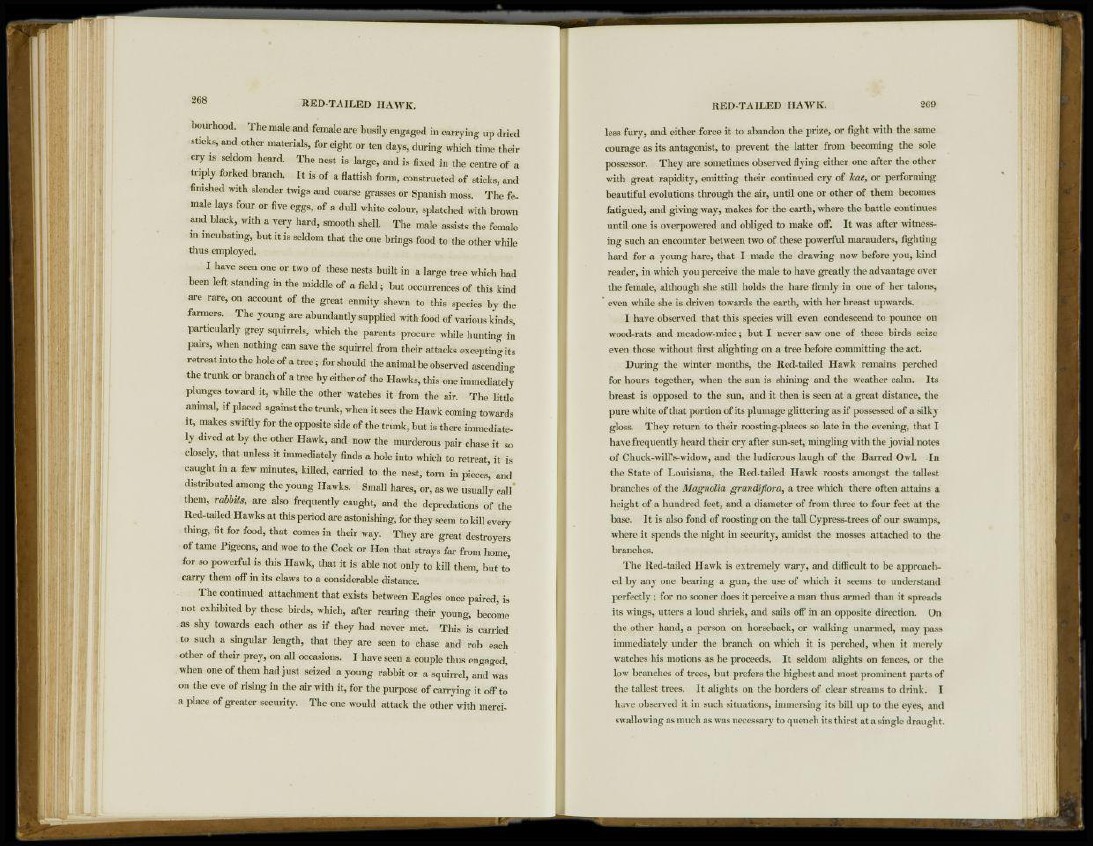
bourhood. The male and female are busily engaged in carrying up dried
sticks, and other materials, for eight or ten days, during which time their
cry is seldom heard. The nest is large, and is fixed in the centre of a
triply forked branch. It is of a flattish form, constructed of sticks, and
finished with slender twigs and coarse grasses or Spanish moss. The female
lays four or five eggs, of a dull white colour, splatched with brown
and black, with a very hard, smooth shell. The male assists the female
in incubating, but it is seldom that the one brings food to the other while
thus employed.
I have seen one or two of these nests built in a large tree which had
been left standing in the middle of a field ; but occurrences of this kind
are rare, on account of the great enmity shewn to this species by the
farmers. The young are abundantly supplied with food of various kinds,
particularly grey squirrels, which the parents procure while hunting in
pairs, when nothing can save the squirrel from their attacks excepting its
retreat into the hole of a tree; for should the animal be observed ascending
the trunk or branch of a tree by either of the Hawks, this one immediately
plunges toward it, while the other watches it from the air. The little
animal, if placed against the trunk, when it sees the Hawk coming towards
it, makes swiftly for the opposite side of the trunk, but is there immediately
dived at by the other Hawk, and now the murderous pair chase it so
closely, that unless it immediately finds a hole into which to retreat, it is
caught in a few minutes, killed, carried to the nest, torn in pieces, and
distributed among the young Hawks. Small hares, or, as we usually call
them, rabbits, are also frequently caught, and the depredations of the
Red-tailed Hawks at this period are astonishing, for they seem to kill every
thing, fit for food, that comes in their way. They are great destroyers
of tame Pigeons, and woe to the Cock or Hen that strays far from home,
for so powerful is this Hawk, that it is able not only to kill them, but to
carry them off in its claws to a considerable distance.
The continued attachment that exists between Eagles once paired, is
not exhibited by these birds, which, after rearing their young, become
as shy towards each other as if they had never met. This is carried
to such a singular length, that they are seen to chase and rob each
other of their prey, on all occasions. I have seen a couple thus engaged,
when one of them had just seized a young rabbit or a squirrel, and was
on the eve of rising in the air with it, for the purpose of carrying it off to
a place of greater security. The one would attack the other with merciless
fury, and either force it to abandon the prize, or fight with the same
courage as its antagonist, to prevent the latter from becoming the sole
possessor. They are sometimes observed flying either one after the other
with great rapidity, emitting their continued cry of Jcae, or performing
beautiful evolutions through the air, until one or other of them becomes
fatigued, and giving way, makes for the earth, where the battle continues
until one is overpowered and obliged to make off. It was after witnessing
such an encounter between two of these powerful marauders, fighting
hard for a young hare, that I made the drawing now before you, kind
reader, in which you perceive the male to have greatly the advantage over
the female, although she still holds the hare firmly in one of her talons,
even while she is driven towards the earth, with her breast upwards.
I have observed that this species will even condescend to pounce on
wood-rats and meadow-mice; but I never saw one of these birds seize
even those without first alighting on a tree before committing the act.
During the winter months, the Red-tailed Hawk remains perched
for hours together, when the sun is shining and the weather calm. Its
breast is opposed to the sun, and it then is seen at a great distance, the
pure white of that portion of its plumage glittering as if possessed of a silky
gloss. They return to their roosting-places so late in the evening, that I
have frequently heard their cry after sun-set, mingling with the jovial notes
of Chuck-wilTs-widow, and the ludicrous laugh of the Barred Owl. In
the State of Louisiana, the Red-tailed Hawk roosts amongst the tallest
branches of the Magnolia grandiflora, a tree which there often attains a
height of a hundred feet, and a diameter of from three to four feet at the
base. It is also fond of roosting on the tall Cypress-trees of our swamps,
where it spends the night in security, amidst the mosses attached to the
branches.
The Red-tailed Hawk is extremely wary, and difficult to be approached
by any one bearing a gun, the use of which it seems to understand
perfectly ; for no sooner does it perceive a man thus armed than it spreads
its wings, utters a loud shriek, and sails off in an opposite direction. On
the other hand, a person on horseback, or walking unarmed, may pass
immediately under the branch on which it is perched, when it merely
watches his motions as he proceeds. It seldom alights on fences, or the
low branches of trees, but prefers the highest and most prominent parts of
the tallest trees. It alights on the borders of clear streams to drink. I
have observed it in such situations, immersing its bill up to the eyes, and
swallowing as much as was necessary to quench its thirst at a single draught.